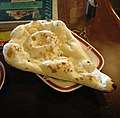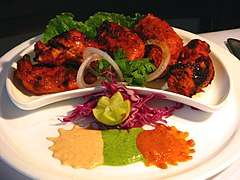Hyderabadi biryani
Hyderabadi biryani is a variety of biryani from Hyderabad, Telangana, India.[1] It is prepared from rice using the dum method of cooking.
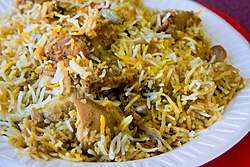 Hyderabadi biryani | |
| Place of origin | India, Pakistan |
|---|---|
| Region or state | Hyderabad |
| Main ingredients |
|
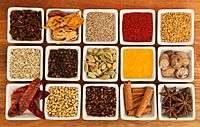 |
| This article is part of the series on |
| Indian cuisine |
|---|
|
Regional cuisines
|
|
Ingredients, types of food
|
|
See also
|
|
Related cuisines |
|
Ingredients
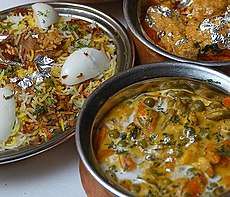 Hyderabadi biryani (on the left) served with other Indian dishes.
Hyderabadi biryani (on the left) served with other Indian dishes.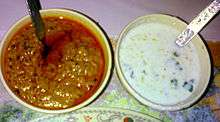
The ingredients are basmati rice, goat meat or chicken or beef, dahi, onions, cinnamon, cloves, cardamom (elaichi), bay leaves, nutmeg, black cumin (shahi jeera), mace flower (javitri), star anise (biryani flower), lemon, and saffron. Coriander leaves and fried onions are used as garnish. The original dish is cooked with red meat but chicken, fish, prawns can be used for some variations. Some people also use vegetables in making this biryani.[1]
History
Hyderabadi biryani is generally believed to have originated in the kitchens of the Nizam of Hyderabad,[2] of the historic Hyderabad State, as a blend of Mughlai and Iranian cuisine.[3][4] Hyderabadi biryani is a staple of Indian cuisine.
Types
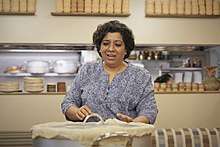
Hyderabadi biryani is of two types: the kachchi (raw) biryani, and the pakki (cooked) biryani.[5]
Kachchi gosht ki biryani
The kachchi biryani is prepared with kachchi gosht (raw meat) marinated with spices overnight and then soaked in curd (dahi) before cooking. The meat is sandwiched between layers of fragrant basmati rice and cooked "in dum" after sealing the handi (vessel) with dough. This is a challenging process as it requires meticulous attention to time and temperature to avoid over- or under-cooking the meat.
Pakki biryani
In a pakki biryani, the meat is marinated for a shorter time and cooked before being layered with the rice and cooked in a dough-sealed vessel. In pakki aqni (with cooked gravy), the ingredients are cooked before baking.
The gravy is redolent of mace, ittar and kewra. Saffron and cardamom are also used.
There is also a vegetarian version of the biryani which is made using vegetables such as carrots, peas, cauliflower, potatoes, and cashews.
Accompaniments
A biryani is usually served with dahi chutney and mirchi ka salan.[3] Baghaar-e-baingan is a common side dish. The salad includes onion, carrot, cucumber, and lemon wedges.
See also
References
- Colleen Taylor Sen (2004). Food culture in India. Greenwood Publication. p. 115. ISBN 0-313-32487-5. Retrieved 12 October 2011.
- "Biryani is an Indian invention". Virsanghvi.com.
- "Telangana / Hyderabad News : Legendary biryani now turns `single'". The Hindu. 18 August 2005. Retrieved 18 February 2011.
- "Of biryani, history and entrepreneurship - Rediff.com Business". In.rediff.com. 9 April 2004. Retrieved 18 February 2011.
- "Metro Plus Chennai / Eating Out : Back to Biryani". The Hindu. 13 June 2005. Retrieved 18 February 2011.
Further reading
- A Princely Legacy, Hyderabadi Cuisine by Pratibha Karan. ISBN 81-7223-318-3, ISBN 978-81-7223-318-1
- Elegant East Indian and Hyderabadi Cuisine by Asema Moosavi. ISBN 0-9699523-0-9
- The Hindu: Hyderabadi Biryani popularity and its variants
External links


